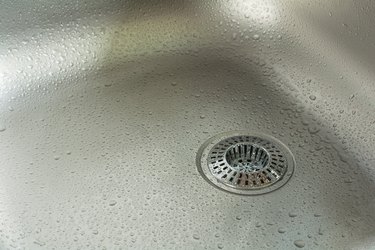
Limescale is a hard chalky deposit consisting mostly of calcium carbonate, and it can make aluminum and other bathroom surfaces look unclean. Limescale is caused by hard water and can build up quickly. It can also appear as a chalky white, grey, pink, red or brown color, depending on the minerals present.
Cleaning Aluminum Sinks
Video of the Day
For everyday cleaning, use warm water, dish soap and a sponge to clean your aluminum sink. Aluminum is a soft metal, so avoid using abrasive pads or brushes. Abrasive materials can cause scratching and damage.
Video of the Day
For a deeper clean and more stubborn stains, start cleaning with dish soap and rinse well. Bob Vila suggest cutting a lemon in half. Dip the half lemon in table salt. Scrub the surface of the sink with the lemon until you see the aluminum get shinier. Rinse the sink well with water and cloth. Dry with a clean towel or rag. This all-natural method will restore the brightness of your aluminum sink.
Cleaning Faucets with Household Products
You can deep clean a faucet covered in limescale using vinegar alone. How To Clean Stuff suggests saturating a paper towel or cloth rag with vinegar. Wrap the towel around the faucet and secure it in place with a rubber band or hair clip. Leave it on the faucet for an hour to really set in. Wipe the faucet clean with a soft cloth. Limescale will wipe right off, and your faucet will go from dull to shiny with this all-natural approach.
Make a baking soda paste to remove caked-on limescale. Mix 3-parts baking soda to 1-part water. Mix together until a paste like consistency is formed. Put the paste onto the faucet. Let it set for about an hour. Wipe it clean and watch the limescale slide right off.
Removing Calcium Buildup in Pots and Pans
If you have hard water stains on pots and pans, you can easily remove them with a few household products. Start by washing the pots and pans with mild dish soap and warm water to remove grease or any food stains. Fill the pot with water, but leave a few inches empty for boiling. Bob Vila suggests using the ratio for each quart of water mix in 2 tablespoons of either lemon juice, cream of tartar or white vinegar. The acidic substances help break down calcium and hard water stains.
Boil the water, then allow it to simmer for approximately 15 minutes. The inside of the pot should look noticeably cleaner and shinier as the water simmers. Once the water has cooled, pour it out. Gently scrub the inside of the pot with a non-scratch scrub sponge or pad. Do not use anything abrasive as it could damage the pot and cause scratching. Rinse it out with water and dry it off with a clean rag.
If there is calcium buildup in pots on the outside of the pot, you can use a non-abrasive metal polish. Read the label to make sure it is compatible with your pots and pans. For a homemade version, you can use the lemon and salt method mentioned above for cleaning aluminum sinks. Do not use these methods for cast iron pots and pans, because this involves acid that can cause damage.
You can use some commercial cleaners to clean aluminum, as well. CLR is a commercial cleanser that is an abbreviation for calcium, lime and rust remover. It is great for cleaning many surface, but CLR on aluminum is not recommended. Instead, try a nonabrasive metal polish.